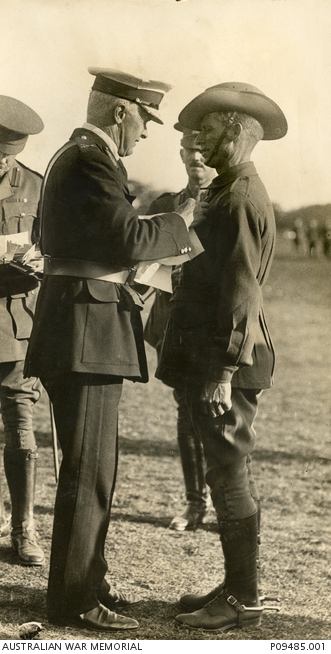
The Governor General awards Charles Grimson the Distinguished Conduct Medal (DCM), TD Cleary, 1915. Image courtesy Australian War Memorial.
Charles Grimson was born in 1876 at Yullundry, Cumnock, to Edmund and Mary Ann Grimson, and was the eldest of six children. The family lived at Norfolk Farm, on the Yullundry Creek.
In early 1901 Charles, aged 25, enlisted to serve in the Boer War. He joined the 3rd Mounted Rifles, and embarked British Princess on 21 March 1901, arriving at Durban, South Africa on 17 April.
Charles served in the Eastern Transvaal and Eastern Orange River Colony in 1901-1902. His regiment took part in several drives in the early part of 1902; the principal one, the Harrismith drive, resulting in the capture of 251 prisoners, 26,000 head of cattle, and 2,000 horses.
Corporal Grimson returned to Australia on 3 June 1902 and was awarded the Queen’s South Africa Medal. Corporal Grimson and other soldiers were presented by the Cumnock community with a gold fob medal in recognition of their gallant efforts on behalf of their King and country at a welcome home banquet and social on Wednesday, 10 September 1902.
Charles Grimson married Ethel Portia Robinson at Newtown, in 1902. He left Cumnock in April 1908 to open a fruit and green grocery store at Yeoval. He later voluntarily sequestrated his estate in the Bankruptcy Court in September 1908 and moved to Hornsby to live.
Charles Grimson enlisted for WWI service on 8 September 1914 in Sydney, aged 38 years, but stated he was 28 years and 5 months on his enlistment form. He embarked from Sydney on HMAT Star of Victoria A16 on 20 October 1914. This ship was also part of the first detachment of the Australian and New Zealand Imperial Expeditionary Forces, which left Albany on 1 November 1914, and disembarked in Egypt on 8 December.
The 1st Light Horse left Alexandria for Gallipoli without their horses, on 12 May 1915. The regiment was deployed near Gaba Tepe, at Quinn’s Post. There were many casualties over the coming days and on the night of 28-29 May, the Turkish Army attacked Quinn’s Post in earnest.
Lance Corporal Charles Grimson was awarded the Distinguished Conduct Medal (DCM):
For conspicuous gallantry on the night of the 28-29 May, 1915, near Gaba Tepe (Dardanelles). Owing to the explosion of a mine which destroyed a portion of our parapet the enemy was able to occupy a portion of our trenches, thus dividing the defending force into two. Lance-Corporal Grimson crawled over the broken ground towards the enemy, capturing successively three Turks. He then, with the greatest courage, entered the remaining portion of the trench held by the enemy, about 12 in number, compelling them all to surrender, thus enabling the defending forces to reunite.
Lance Corporal Grimson received a gunshot wound to the foot on 5 June 1915 and spent several months in hospitals in Alexandria and Cairo before embarking to return to Australia on 9 September. He was discharged on 22 November 1915. As well as the Distinguished Conduct Medal, he was awarded the 1914-15 Star Medal, the British War Medal 1914-20, and the Victory Medal.
The Cumnock Recruiting Association also presented Lance Corporal Grimson with a purse of sovereigns and a gold medal after his return. He promoted enlistment to the AIF at many community functions before returning to his home in Hornsby, which he renamed “Quinn’s Post”.
In the 1930 and 1936 NSW Electoral Rolls, Charles Grimson is recorded as living at Gardiner Road, Orange and his occupation was a farmer. Charles and his wife Ethel would have received a shock when they were told that the murdered body of a man whose charred body was found at Julia Creek in October 1931 may be that of their third son, Frank Robinson Grimson, who had disappeared the year before when taking horses to a station in North Queensland. However, the identification was in error as later that month, Frank turned up living at Kuridala, near Cloncurry, Queensland. Frank was reportedly one of ten children of Charles and Ethel Grimson. He later served with 2/28 Battalion in WWII and died of wounds at El Alamein, Egypt, in November 1942.
Charles Grimson died on 20 October 1939, aged 62 years, and is buried in the Orange Cemetery. He is commemorated on the Molong RSL Honour Roll and the Cumnock War Memorial Gates.
Charles’ brother, Frederick Daniel Grimson, also served in WWI; he died of illness in April 1917 while serving in France.
Molong Argus, 24 September 1915, p. 4.
Lance-Corporal Grimson DCM, How Cumnock Received Him
* Peter Tremain, Dianne Strahan and Val McKenzie, August 2016
Cumnock NSW War Memorials


